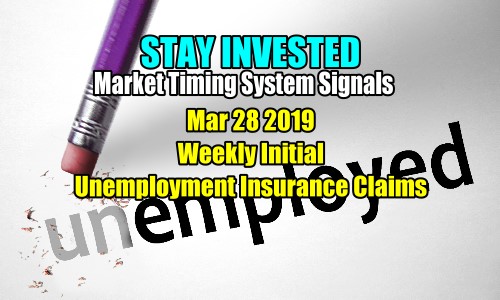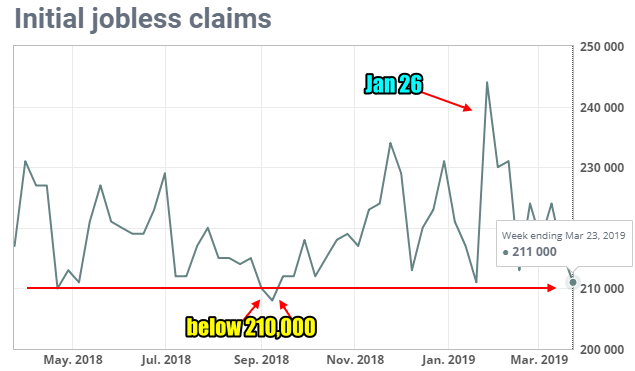
Today’s Weekly Initial Unemployment Insurance Claims came in at 211,000 meaning that the rate of layoffs is at half-century lows. In other words, the economy is humming along despite what economists indicate are signals of a slowing economy both globally and domestically.
This is the second Weekly Initial Unemployment Insurance Claims report in a row that shows strong employment levels and another week of lower unemployment benefits being claimed. In other words, people are still being employed at record numbers.
Market Timing System
The Weekly Initial Unemployment Insurance Claims has been a Market Timing System I have used since the mid-1970’s. They have warned me about the bear markets of 1974, 1987, 2000 and 2007. Since 2009 the Weekly Initial Unemployment Insurance Claims have advised to stay invested in stocks. Even in the dips from October to December 2018, this market timing system advised to stay invested.
I have found it to be the most accurate as far as an early warning system for a major trend change. I have definitely found it to be better than the inverted yield curve which is often months if not a couple of years early. Instead I find the Weekly Initial Unemployment Insurance Claims and the monthly non-farm payrolls can advise when to start turning cautious and when to begin to reduce exposure to stocks and increase exposure to bonds and utilities.
Looking at the Weekly Initial Unemployment Insurance Claims for the past 12 months you can see that in January, claims rose most likely as a result of the government shutdown. Since then the weekly claims have declined indicating more employment. Today’s numbers match week ending Jan 19 at 211,000 and are the lowest since September 8 2018 which was a period when Weekly Initial Unemployment Insurance Claims fell below 210,000 which was a strong signal advising to stay invested despite the stock market decline of October through to the end of December.

Weekly Initial Unemployment Insurance Claims – Chart From Labor Department
Market Timing System Signals – Stay Invested
As members and regular readers of FullyInformed.com know, I use the unemployment reports and the Weekly Initial Unemployment Insurance Claims as market timing systems. I started investing just before the worst bear market of the 1970’s (unfortunately) that wiped out 45% of the index gains, let alone the damage it did to individual stocks. I have used the unemployment reports on and off since that time and found them to be quite accurate at predicting when economic cycles are changing, both for contractions and for expansions.
The market timing system built around these Weekly Initial Unemployment Insurance Claims is presently advising that despite the news on the inverted yield curve, the economy is humming along just fine.
The inverted yield curve is a lagging indicator, meaning that the events that it may be predicting could be months if not a couple of years away. In contrast, the Weekly Initial Unemployment Insurance Claims gives us a weekly update on how the economy in general is doing and right now it is advising to stay invested.
Next week on Friday April 5 we will get the March non-farm payroll numbers. The February non-farm payroll numbers were a shocker. Next week we get to see what March’s numbers look like and whether February’s numbers were an anomaly or a harbinger of changes that we cannot see at present but which are coming further in time.
Right now the Weekly Initial Unemployment Insurance Claims indicate that the February numbers were either an error or an anomaly because the weekly trend does not support the non-farm payroll numbers that were released for February. Next week is important and I will be putting together a trade on the Thursday ahead of the non-farm payroll numbers.
Members will receive notice of that trade’s setup on Wednesday April 3 and after it is posted on Thursday April 4. These have been highly profitable trades done monthly for the past 14 years with, so far, not one month of losses. That’s a pretty good track record.
Market Timing Articles
Here is a list of articles that can assist investors in setting up their own market timing systems or methods for profit and income.
Signals To Stay Invested – Reading The Weekly Initial Unemployment Insurance Claims From Oct 5 2017
Oct 5 2017: A review of the Weekly Initial Unemployment Insurance Claims and how it reflects on the market timing system that uses the unemployment reports to determine when to enter and exit the stock markets.
Understanding Risk With The Weekly Initial Unemployment Insurance Claims Signals
May 12 2016 – Every Thursday the Labor Department issues the Weekly Initial Unemployment Insurance Claims. After almost a year of declining numbers, today’s report shows the third weekly increase in claims. With weekly claims nearing 300,000 here is what this market timing system advised investors to consider.
Profiting From Using The Weekly Initial Unemployment Insurance Claims Signals
Feb 27, 2014 – The Weekly Initial Unemployment Insurance Claims are perhaps one of the best market timing systems I have available. Here is the method I use based on the signals received from the Weekly Initial Unemployment Insurance Claims every Thursday which helps guide which strategies should be used and when.
Knowing When To Commit Capital and When To Stay Out
Jul 07, 2013 – Investors continually find their portfolios damaged and experience large losses by entering the stock market at the wrong time. Market timing is not the easiest thing to do but this strategy is one I have used since the early 1970’s to advise me when to get my capital back into the stock market and when I should stay out of the market or take my profits.
Market Timing and Understanding Short-Term Signals
Jun 13, 2012 – There are three levels of market timing, longer-term, long-term, mid-term and short-term. Every night I put up my short-term outlook which I follow consistently in order to profit from the market direction. In this article I discuss how I use market timing indicators to keep me on the right side of the market and how I combine all the various market-timing levels in order to stay profitable and stay invested even during the worst market conditions.
Market Timing What Is It and How To Use It
Nov 05, 2011 – Even for the skeptics this article is worth reading as it lays out what is meant by the term Market Timing and how every investor should consider using it in their day-to-day investing and trading. This is a great place to start for gaining an understanding of market timing in general.
Market Timing Systems
Here are a few other articles on market timing systems
Market Timing and Understanding MACD Histogram
Apr 12, 2012 – MACD (Moving Average Convergence / Divergence) Histogram is another market timing system used by thousands of investors. In this article I look at how good a technical tool it is for timing when to get in and get out of the stock market.
Market Timing System Using Weekly Initial Unemployment Insurance Claims
Jul 07, 2012 – Probably one of the best market timing system methods I have encountered to date. Nothing is foolproof but this system has kept me in and out of the trouble for years. It is excellent at advising when to stay long in the market and keep committing capital to more positions including naked puts and when to turn my capital towards bear ETFs and Ultra Short ETFs. Excellent is just about every way I can think of I follow this system every Thursday when the Weekly Initial Unemployment Insurance Claims reports are released.
Market Timing System Using the VIX Index To Trade Market Direction
Dec 30, 2012 – Another great system which I have found incredibly profitable is trading the VIX Index call options against the market direction. This market timing system has many benefits including profiting from market gyrations.
Market Timing System Update on the Weekly Initial Unemployment Insurance Claims
Mar 20, 2014 – The Weekly Initial Unemployment Insurance Claims remains one of the better market timing systems. It has a long track record of proven performance. With the market direction stuck near all-time highs many investors must wonder if this market timing system can continue to provide the guidance to stay invested safely.
